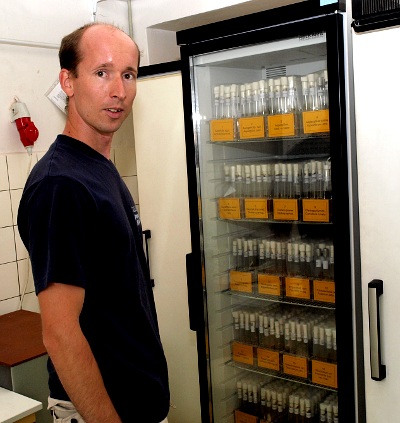August 17th, 2011; By: Marie Kohoutová; Section: Interviews & Portraits
Museums and art galleries usually display outstanding works of art. In the case of the Culture Collection of Fungi (CCF) of the Department of Botany of the Charles University Faculty of Science, the unique exhibits on display are mushrooms. And it is not totally off the point to compare mushrooms to works of art.
“When you study microscopic fungi for a long time, you find out that these mushrooms abound in colour and unbelievable structures that cannot be found anywhere else in nature and which, in the positive sense, border on art,” says the head of the mycology working group and CCF staffer Mgr. Ondřej Koukol, PhD..
The Culture Collection of Fungi is a teaching facility for faculty students and it also communicates with the expert community, providing different services to it. It is usually people from other universities who turn to us when they need to send or determine some fungi. Or someone from the food industry needs to determine a phylum that has sprouted somewhere and they need to find out whether it can potentially produce mycotoxins and how dangerous it is. And that’s about all. What is the possible use of fungi in medicine, pharmacy and industry? Fungi have a large biotechnological potential based primarily on fungal metabolites which can be used in medicine. On the other hand, the number of fungi infecting humans is growing all the time. Clinical material provides ever more frequent evidence of new species that can adapt to humans as their substrate. They mainly cause only topical mycoses but sometimes even systemic ones – and this number grows in proportion to people’s excessive concern with hygiene, life under stress, or the weakening effect of different chronic diseases, etc. Yet mushrooms have an ever growing beneficial potential, be it as food or food supplements. We extract a large number of medicines from fungi, not just antibiotics but also drugs lowering cholesterol levels, immunosuppressive drugs, etc. Of course, fungal enzymes are applied in different branches of industry; they are used not only in the food industry but also in the processing of wood, paper, leather and other natural materials, as emollients, bleaches, etc. |
|
People are usually more interested in the larger mushrooms |
What are mushrooms in fact? Feared and unwanted visitors or welcome helpers, for example in pharmaceutics?
Either. Our collection consists of saprophytic fungi which grow on dead organic matter. They are also occasional human parasites. We have a large collection of fungi of the Aspergillus genus whose many strains come from the clinical material collected from different patients. They were mostly immunocompromised individuals (such as leukaemia patients), or individuals whose system is very weakened, for example as a result of chemotherapy.
From what you indicated, it seems that mushrooms get the better of humans…
You could say so because we definitely don’t rule them, we study or use them at best but when the going gets tough, mushrooms can give us a hard time. For example once you get dry rot in your cottage, there is nothing you can do about it. If you have high humidity in your flat, you will have difficulties getting rid of fungal colonies on your walls. Another critical spot are dirty air conditioning systems and damp rooms with poor ventilation and large circulation of people. Fungal colonies can be hiding there, producing volatile substances into the environment, resulting is a long term exposure of humans to an environment which weakens them.
It is mushrooms that affect us not the other way round! So we can say that if they choose to, they can control us quite efficiently, they can even get us into a pickle. And if we don’t know the cause, there is nothing we can do about it.
Are you yourself afraid of mushrooms?
No, I’m not afraid but I’m more cautious. If I find a colony in jam jar, I know it’s no fun and there is a lot of uncertainty whether the colony produces toxins or not. Knowing what toxins can do, I rather throw out the whole jar. But if I still hesitated about throwing it out, I would isolate the fungus, determine it and find out in literature whether it is a potential mycotoxin producer. However such conditions can always arise under which a fungus which normally does not produce toxins will do so.
Thank you for your time.















